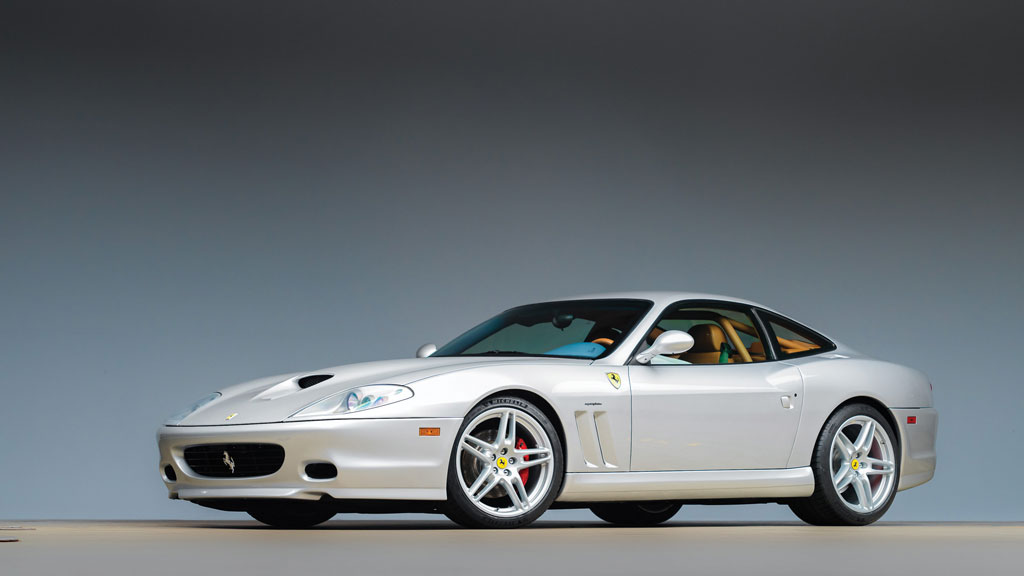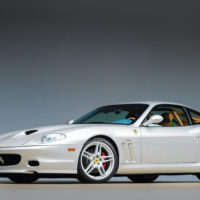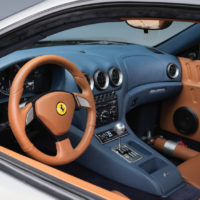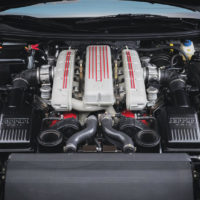SCM Analysis
Detailing
| Vehicle: | 2002 Ferrari 575M Maranello |
This car, Lot 59134, sold for $186,000, including buyer’s premium, on Bring a Trailer on November 9, 2021.
A recent “Saturday Night Live” skit, “Car Heist,” features an expert thief named “Ghost,” who breaks into a guarded garage through its roof. His accomplice, the obligatory computer hacker, is orchestrating the robbery from a remote location. Ghost’s target is a black Lamborghini Diablo, which is being stolen to fill an order by a client. The theft is foiled by the Ghost’s inability to overcome the Diablo’s so-called “advanced driving system,” consisting of “three pedals” and “a shifter that moves up, down, and sideways.”
Of course, the advanced driving system is a conventional manual transmission and as the thief is given a tutorial on its operation, it becomes obvious the heist is doomed. The skit rather amusingly brought home the fact that few young Americans have had an opportunity to drive a stick-shift car.
The great divide
I have struggled with the obsession with “gated shifters” and “three-pedal” cars. When you read comments in forums and auction sites, driving a stick would appear an Olympic-level talent and mastering a manual transmission seems to be akin to achieving automotive nirvana. Comments on this auction included, “These cars truly need ‘a pro’ behind the wheel,” and, “My F355 6-speed requires a Ph.D. in toe-heel to make the vehicle dance.”
It makes me want to scream, “My grandmother could drive a manual F355! They are no more difficult to drive than a manual 1955 Chevy.”
This is where I have to remember that the skill set that I take for granted really is foreign to many of today’s drivers. Shift levers and clutches are as fascinating to them as F1 transmissions are to me.
Ferrari introduced the F355 F1 berlinetta in 1997. It was the first time an F1-style electro-hydraulic transmission was offered in any production car. Albeit clunky, the transmission was revolutionary. The F1 utilized a standard manual transmission complete with a clutch, which is shifted by flicking a steering-column-mounted paddle. Its ability to blip the throttle and perfectly match revs on a downshift was nothing short of magic. Over the next few years, Ferrari upgraded the F1 gearbox for lightning-fast shifts, giving Ferrari drivers a tool worthy of its F1 name.
In 2006, Ferrari introduced the 599 GTB Fiorano. It would be the last production Ferrari model available with a manual. Other manufacturers followed with their versions of an F1 transmission, and today paddle-shift transmissions are the industry standard for high-performance sports cars.
Collectors and manual-shift enthusiasts soon recognized the demise of new manual-equipped Ferraris. A super-strong auction sale of a three-pedal 599 woke the market, and a rush on low-production modern models with gated shifters followed.
Conversion considerations
Repairing an F1 transmission is expensive and difficult and a shortage of parts does not help. Converting from paddle shift to stick shift is a viable alternative. The potential added value of a conventional manual transmission makes the economics of a conversion start to make sense. A couple of enterprising shops took on the conversion of an F1 transmission to a stick shift and found it possible. As word spread, a cottage industry was spawned to commercially convert F1 units to three-pedal manuals.
Conversions have been done with gated transmissions salvaged from wrecks, parts purchased from Ferrari, and most recently, from kits made up of parts fabricated by shops. Conversions are quite popular. An internet search found conversion kits for five different Ferrari models. A pioneer in this field has reportedly converted over 80 cars so far.
The final result can vary. The cosmetics of an F1 and manual Ferrari are different. An F1 version will have a display on the dash indicating which gear the car is in. The manual version does not. An F1 599 GTB has a carbon-fiber console; the manual does not. But the biggest issue is the F1 ECU.
An F1 ECU captures information such as throttle position, speed, rpm and shift-paddle movement to manage the engine and shift the transmission. Manual-shift ECUs use much different parameters. F1 ECUs must be programmed to work with a manual-shift car. Ferrari is not interested in reprograming them, so they are “hacked” to make the car run. The result depends on the programmer’s skill, but passing a California emission inspection with a hacked ECU is an uncertain proposition.
Dollars and sense
Our subject 575M Maranello was converted from F1 to gated manual. The seller disclosed the work and named the shop that did the work. There was huge interest in the auction, gathering a staggering 19,219 views. Some 1,351 people signed up to watch the auction, which pulled 143 comments. The auction finished with a $186,000 sale price after buyer’s premium.
Ferrari’s worldwide production of manual-shift 575M Maranellos was reportedly a scant 246 examples. If you could find one, you should expect to pay over $250,000 for a good example. Meanwhile, a good 575M F1 will run in the $90,000–$120,000 range. The cost of a conversion is about $30,000–$50,000.
This sale was clearly about the cost of the car and the conversion, and was fair to both parties. The seller got their investment back and the buyer got a manual-shift 575M for far less than a factory-built example.
Before you buy…
Expect to see more manual conversions hit the market, as early adopters move on to the next big thing. Premiums will drop as the market recognizes the supply of conversions is only limited to the number of F1 examples available. Prices should settle at a little less than the cost of a donor car plus the conversion.
Conversions should not dilute the value of the factory-built stick-shift examples. The conversion buyer is a driver, and the factory-built buyer is a collector. The collector will not consider a conversion and a driver will not pay up for a garage queen.
A few words of caution: Unscrupulous sellers may omit telling you their car is a conversion or may imply it is a factory-built manual when it is not. Check with Ferrari to make sure it is the real thing. Also, ask your local Ferrari dealer if they will service conversions; some will not. Further, many dealers will not buy a conversion, take it in trade or even sell it on consignment, so a conversion may not be as liquid as you think. Thinking about showing your car? Conversions are not eligible for judging at many Ferrari events. Finally, make sure the car will pass inspection. A reprogrammed ECU may throw an error code on your state’s emission computer, and you will not be able to register your car. ♦
(Introductory description courtesy of Bring a Trailer.)



